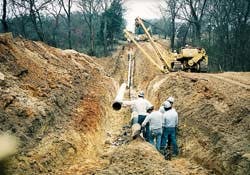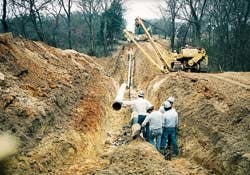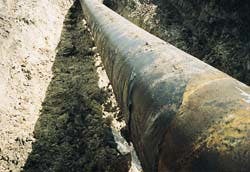U.S. risk management can reduce regulation, enhance safety
Theodore L. Willke
Gas Research Institute
ChicagoTheresa M. Shires, R. Michael Cowgill
Radian International LLC
AustinBernd J. Selig
Hartford Steam Boiler Inspection & Insurance Co.
Hartford
Isolated internal corrosion led to replacement of this 200-ft section of a 45-mile pipeline. (Photo from Fluor Daniel Inc., Sugar Land, Tex.)
Deteriorated coating on this 24-in. pipeline shows why operating companies should be concerned about the conditions of their older pipelines with outdated coatings. (Photo from Fluor Daniel Inc., Sugar Land, Tex.)The only way to slow the spiraling costs of new prescriptive pipeline regulations is to develop an effective risk-management program, one that will focus on the highest priority safety issues not minimum compliance with regulation.
If applied systematically and rigorously, risk management can help pipeline operators focus on safety issues specific to their own systems. These operators have a greater understanding of the condition of their systems and what it takes to keep them operating safely.
This knowledge, along with the flexibility inherent in the U.S. approach to risk management, can lead to a more effective use of resources devoted to pipeline safety.
When an accident occurs, data generated in a risk-management program will provide a mechanism for understanding the causes of an incident. Such information can also direct future efforts toward the most effective actions to ensure that similar incidents are unlikely to occur again.
Two incidents
Public concern resulting from two highly visible pipeline incidents has prompted the U.S. pipeline industry to explore risk management as an alternative to prescriptive regulation.
In 1993, an oil-products pipeline ruptured and poured thousands of gallons of diesel fuel into the Potomac River in Washington, D.C. This brought pipeline safety directly to the attention of Congress.
Then in March 1994, a large-diameter natural gas pipeline ruptured in Edison, N.J. The resulting fire was visible in New York City. There were no direct fatalities, but several hundred people were driven from their homes as eight apartment buildings burned to the ground.
After a highly visible pipeline rupture in which people or property are threatened, the public demands that actions be taken to prevent a similar accident. The typical response has been to call for additional regulations.
The resulting reactionary regulations add additional expense to pipeline operations without necessarily improving pipeline safety measurably. In both incidents described, the pipeline companies were complying with the existing regulations.
This leads to a fundamental question: Are prescriptive regulations the right response or should an alternative approach be considered?
Partly in response to these incidents, the natural-gas pipeline industry, the hazardous-liquids pipeline industry, and the U.S. Department of Transportation (DOT) have joined forces to explore ways of enhancing pipeline safety through implementation of a risk-management program.
Risk management offers a method of identifying risks, evaluating them based on their likelihood and severity of consequences, and allocating resources to control them based on their importance.
Current regulation, safety
About 280,000 miles of high-pressure, cross-country pipeline transport natural gas in the U.S. This pipe was built primarily in the 1950s, 1960s, and 1970s, although there is pipe in the ground from the early 1900s.
Annual construction of new pipelines, for which most of the existing regulations and standards were written, accounts for only 1-2% of total pipeline mileage. Therefore, pipeline-safety efforts must be focused on the large installed base of existing pipelines.
By any statistical measure, the U.S. pipeline system is the safest form of transportation.1 And where pipeline-related fatalities are compared to automobile accidents, falling objects, or lightning, pipelines are demonstrably safe (Fig. 1 [29796 bytes]).2
But public perceptions are shaped by what is portrayed in the media, especially television. Public outrage in response to catastrophic accidents, combined with the propensity toward litigation, have promoted increasing levels of regulation.
This "safety at any cost" mentality has resulted in an influx of prescriptive regulations,3 often imposed without consideration of the real impact on pipeline safety.
The DOT's Office of Pipeline Safety (OPS) regulates the transportation of natural gas and hazardous liquids under the Code of Federal Regulations (CFR; Parts 192 and 195, respectively) as legislated over the years through the Pipeline Safety Act and its reauthorizations.
These regulations were originally adapted from national standards, such as the ASME B31.8, but have evolved over time to address specific concerns of the public and Congress, typically in response to a highly visible pipeline rupture.
Late last year, OPS published a program framework to negotiate, approve, monitor, and modify risk-management plans that natural gas and hazardous liquid pipeline companies would implement during a 4-year risk-management demonstration project.4
The Accountable Pipeline Safety and Partnership Act became law Oct. 12, 1996.
As early as 1994, the U.S. natural-gas pipeline industry joined with the hazardous-liquids pipeline industry and OPS to examine how risk management might be used to enhance pipeline safety.
Two joint industry/government risk-management teams were established; one for natural-gas pipelines and one for hazardous-liquid pipelines. These teams focused on developing a framework in which risk management could be implemented by the pipeline industry with the support and approval of OPS.
Based on recommendations from these teams, OPS through July 25, 1997, is soliciting operator participation in risk-management demonstration projects to evaluate the merit of risk management as a way to improve safety, environmental protection, and reliability. Five building blocks are being developed:5
1. A program framework to shape how DOT will solicit, approve, and oversee risk-management plans submitted by pipeline operators
2. A risk-management program standard to guide development and implementation of a risk-management plan by pipeline operators
3. Performance measures and a baseline of performance to test whether risk management results in equal or greater levels of safety than prescriptive regulations as currently practiced and to test whether risk management is an effective alternative to the traditional regulatory framework
4. The communications plan to identify program goals, key messages about risk management and program administration, and opportunities for the public to get information and ask questions about the demonstration program activities and developments
5. The training plan to educate participants in the other four blocks.
The Gas Research Institute (GRI), Chicago, Radian International, Austin, Cycla Corp., Alexandria, Va., and the Hartford Steam Boiler Inspection & Insurance Co., Hartford, Conn., supported these efforts by providing background information on risk-management methods and practices throughout the world.
This team has been working with the industry and OPS to develop guidelines for design and implementation of risk-management programs by the pipeline industry. It is expected that guidelines will be adopted as standards in the future, either as new regulations or as national consensus standards.
As input to this process, GRI has published four reports (1995) on risk-management practices in the natural-gas industry, practices in other industries around the world, common terminology and definitions, and methods and tools available for application.
A video on the basics of pipeline risk management was prepared to supplement these reports. GRI has also been developing a number of advanced information systems and pipeline integrity tools for use by the industry in a risk-management program.
Definitions
Risk is the frequency or probability of an event (generally thought of as being hazardous) occurring multiplied by the severity or consequence of the event.
As an example, traveling in an airliner is safer than riding in an automobile.
Clearly, however, the consequences of an airline accident are greater because of the number of injuries or deaths that result from a single accident. Conversely, fewer people die in a given automobile accident.
But the frequency of automobile accidents is very high compared to the frequency of airline accidents, resulting in a greater overall risk to public safety from automobiles than airline travel.
Risk management is a systematic focusing of limited resources on those activities with the greatest potential for reducing risk. Risk cannot be eliminated but can be managed.
Available resources can be used in a disciplined process of risk management to focus industry efforts on the best means of enhancing pipeline safety.
The focus of risk management must be the prevention of hazardous incidents and the mitigation of their consequences. Fig. 2 [21799 bytes] presents a risk-analysis matrix.
The horizontal axis shows the severity of an incident; the vertical axis, the frequency of incidents. The most desirable situation is to experience both low frequency and low severity (lower left corner).
Most safety efforts tend to focus on high-frequency events simply because more information is available. And the information can be used effectively in designing prevention or mitigation measures.
Alternatively, the public perception of risk tends to focus attention on the most severe and unpredictable incidents. These are the most visible to the public and cause the greatest public outcry. Risk management addresses both aspects of risk-frequency and severity.
A well-designed and effectively executed program of risk management is comprehensive, systematic, and rigorous (Fig. 3 [29856 bytes]).
- The first step is risk assessment: identifying the sources of risk-the potential hazards-and evaluating the probability and the severity of the consequences arising from a hazardous incident.
- The second step is risk control, decision-making, and implementation: choosing appropriate measures to reduce risk and allocating resources.
- The third step is performance monitoring: the measurement of performance lets industry, safety regulators, and the public know what progress is being made towards greater safety.
Other U.S. industries
Risk-management programs have been pursued by many U.S. industries, including the chemical and nuclear power industries.6
The Chemical Manufacturers Association adopted the Responsible Care program in 1989 in response to highly publicized chemical-plant incidents and regulations mandating the publication of air-toxics emissions data.
Responsible Care's six codes of management practice aim to improve performance in health and safety, effects on the environment, and public relations.
In response to the Clean Air Act Amendments of 1990, the U.S. Occupational Safety & Health Administration (OSHA) issued regulations for Process Safety Management in 1992. These regulations provide 14 elements designed to protect employees from hazards associated with accidental releases of highly hazardous chemicals in the workplace.
Likewise, the U.S. Environmental Protection Agency (EPA) in June 1996 adopted regulations for a formal Risk Management Plan (RMP) to prevent accidental releases of chemicals that pose the greatest threat to the public and the environment.
Risk-management practices began in the nuclear-power industry when civilian power plants were first licensed in the U.S. That industry performs risk-based inspections based upon standards developed by ASME and follows the Nuclear Regulatory Commission's mandates about probabilistic risk assessment in design, operation, and maintenance of nuclear-power plants.
The U.S. nuclear-power industry never resolved the safety issues in the minds of the public even with the use of risk assessments to guide their efforts. Their primary mistake was to exclude the public from the risk-management process-an important lesson for the pipeline industry.
Probabilistic risk assessments (PRA) were initially used by the nuclear industry to evaluate measures to prevent or mitigate the worst-case accident-the loss of coolant to the reactor core leading to a core meltdown (the China Syndrome).
By focusing only on the worst-case scenario, the cost of addressing this low-probability event caused costs to spiral upward until nuclear power was no longer cost-competitive.
The high costs of the PRA and the costs of preventive and mitigative measures resulting from these assessments are reasons the pipeline industry opposes regulation based on PRA.
Prescriptive regulation
Understanding the unique approach to risk management being taken by the pipeline industry and OPS involves making distinctions between national engineering standards, prescriptive regulations including risk-based regulation, tiered regulations, PRA, and risk management.
Like other industries, the pipeline industry participates in development of national engineering standards through codes and standards-writing organizations. These incorporate engineering studies and good engineering practice into standards that are voluntarily accepted by an industry.
Although U.S. pipeline-safety regulations were originally based upon national consensus standards developed by professional standards organizations such as ASME, pipeline-safety regulations are increasingly the result of Congressional mandates in response to pipeline accidents.
These regulations are applied uniformly without regard for the diversity of U.S. pipeline systems and operations. Such regulations are prescriptive: all companies subject to the regulations must comply unless granted a waiver.
Regulations can specify the minimum requirements that must be met, including the method of compliance (e.g., the design requirements for valves under CFR 192.145 and 195.116).
Alternatively, performance-based regulations specify the desired outcome but leave the actual method of compliance up to the companies (such as the requirements for gas and liquid pipeline operators to establish a public education program under CFR 192.616 and 195.440).
In recent years, many new regulations have been written to account explicitly for risk. Under risk-based regulation, the risks of specified hazards are assessed, and regulations are written to reduce the risk to a desired level.
Risk-based regulations may allow different methods of compliance depending on circumstances. Implicitly, the class-location regulations (which specify the allowable stress levels in pipelines depending upon the proximity of human habitation), or the API's proposed alternative to the hydrotest rule are examples of risk-based regulations.
Risk-based regulations can offer less flexibility than performance-based regulations.
In other industries around the world, it is becoming common to develop probability-based performance standards instead of specified minimum compliance regulations.
Probability-based performance standards relate risk to a desired social outcome stated in terms of the probability of risk to human life and the environment.
For example, the standard might be <1 in 1 million chances of death/1,000 miles of pipe/year. design features and operating practices are then studied to determine whether this level of safety can be reached.
Quantitative risk assessment (QRA) and PRA are the principal methods used in setting probability-based performance standards. Under these regimens, companies apply for approval of construction plans and must show by analytical means that the proposed construction can meet the specified performance standard.
Typically, the analytical effort would involve scenario writing, simulation modeling, and calculations of probability and severity of consequences from probable hazardous incidents.
Generally, U.S. pipeline companies view probability-based performance standards as onerous as prescriptive regulations.
In addition, the explicit definition of an acceptable level of safety in terms of the chance of deaths per incident makes most of the pipeline industry, as well as the public, extremely uncomfortable.
U.S. approach
The risk-management alternative as currently defined for the U.S. pipeline industry has four distinctive features:
1. Risk management as an alternative to prescriptive regulations
2. Implementation of risk management by pipeline companies
3. Public accountability of pipeline operators through a performance-based system of measurement and monitoring
4. An orientation towards accident prevention.
Alternative to regulation
The first priority of the pipeline industry is to ensure safe, reliable delivery of natural gas and liquids at a reasonable cost to consumers.
Both industry and government regulators have come to believe that risk-management programs would be a more effective method of achieving pipeline safety goals than a continuation of prescriptive regulations.
The key to the U.S. approach is to substitute risk-management programs, focused on safety issues and designed and managed by pipeline companies, for the current system of prescriptive regulations focused on minimum compliance.
Implementation
The U.S. pipeline system is diverse with respect to proximity to population, vintage of pipe, climate and soil conditions, and maintenance and operating history.
Under risk management, each company would be given the flexibility to use the best practices for its system, consistent with a comprehensive risk-management plan.
In contrast to current OPS regulations, authority for determining how to build, operate, and maintain pipeline systems under risk management would shift from the government to the industry.
Risk management plans would be approved by the federal government, but they would be designed and implemented by individual pipeline companies. Federal officials would monitor compliance with an approved risk-management plan.
For this decentralization to work, there must be standards for the design and implementation of an approved risk-management program.
Performance measurement
Operator flexibility does not mean complete freedom and autonomy. Each pipeline operator must demonstrate to the government and the public that risk management enhances pipeline safety.
The program framework for the risk-management demonstration projects stipulates that participating pipeline companies must deliver an "equivalent or higher level" of safety, environmental protection, and reliability.4
The key to making risk management work to the satisfaction of the public is a regulatory framework that provides public accountability through measurement of performance. Under risk management, a pipeline operator will submit performance data to the regulators for evaluation.
If risk management is successful in enhancing pipeline safety, then the trend in incidents or precursors of incidents should decline. This is the test of effectiveness and focus on continuous improvement, elements missing in most other "risk-management" regulations.
Perhaps the biggest obstacles in implementing a regulatory system that incorporates risk management is the lack of available data to establish a baseline level of safety for comparison.
Since there are few major incidents and few pipeline-related fatalities, industry and government must find other ways of measuring safety performance.
One way is to look for precursors of incidents, or "near misses." Such precursors might be unsafe conditions found, or possibly, unauthorized pipeline crossings or pipeline hits by third parties.
Even if industry and government can agree on a set of performance measures, today we do not have a history or "baseline" to determine whether risk management results in greater levels of safety.
For this reason, among others, DOT's regulatory framework for risk-management demonstrations sets up a 4-year period for each participating company to test the effectiveness of risk management. It may take longer than 4 years to establish a performance baseline for the industry, but at least it is a start.
Accident prevention
Under risk-management, attention is focused on ways to prevent accidents from occurring and to mitigate the consequences.
Risk management requires that a pipeline operator set up a systematic, formal process for assessing risk and allocating resources to reducing risk.
The steps require understanding the root causes of pipeline risks, identifying potential hazards, and assessing the probability and consequences from these hazards. The focus of attention is on safety issues, environmental protection, and system reliability.
The orientation of risk management is to focus on risk reduction where most effective, which for pipelines tends to emphasize the prevention of accidents. This represents a dramatic departure from today's emphasis on compliance with minimum standards in the pipeline safety regulations.
Issues to be resolved
Changes in pipeline safety regulations require dramatic shifts in the way people think and perform their jobs, whether pipeline safety regulators or pipeline operators.
Not unlike the "quality" revolutions that took place in the 1980s, risk management will require a change in culture within companies and within the regulatory community. Risk management diffuses the "bright white line" of regulations by introducing subjectivity into the determination of compliance.
There are legal liability concerns among all parties. Regulators are concerned that approval of risk-management plans will expose them to liability if incidents occur in areas in which variations from minimum compliance are allowed. Pipeline operators share the same concern plus the exposure to litigation that could occur under the legal process of discovery.
There was initial concern among safety regulators that pipeline operators might use risk management as an excuse for reducing the resources dedicated to pipeline safety.
But pipeline operators are concerned that risk management may become much more expensive to implement, at least in the short run.
The requirement for a measure of performance to judge the success of risk management, both in terms of the overall level of safety and the program as an alternative to prescriptive regulations, poses a dilemma for the pipeline industry.
The true measure of safety performance is a reduction in the frequency and severity of pipeline loss of containment, but ruptures and spills occur so infrequently that it would be impossible to prove a statistical difference in a 4-year time period.
An alternative measure (or measures), one that has an established baseline and can be demonstrated to show a change in a 4-year period, has not yet been agreed upon by both pipeline operators and regulators.
Each of these issues highlights the matter of trust between the industry and the government. There is a natural adversarial relationship between the regulator and the regulated.
Risk management requires greater cooperation.
GRI's role
As said before, acquiring the right data for performance monitoring is the biggest technical issue. This is compounded by the lack of a baseline with which to measure future performance.
GRI is developing several data management systems to help address this situation including the Pipeline Inspection and Maintenance Optimization System (Pimos), the Incident Reporting and Trending System (Irats), and Integrated Spatial Analysis Techniques (ISAT) program.
Pimos is a computer-based pipeline management system designed to assist gas-pipeline companies in effectively allocating operating and maintenance resources. This program provides a consensus methodology for evaluating a pipeline system and identifying potential incident locations.
Based on company incident records, correlations with hydrogeological relationships, historical records, and current cost estimates of mitigation activities, the program provides recommendations for operating and maintenance strategies where each strategy has a unique effectiveness and implementation cost.
Irats provides a common methodology to assist in the collection and timely reporting of critical incident data. A common dictionary ensures the collection of comparable data and allows trending analyses.
Data collected when the report is being compiled can be used to support additional pipeline safety initiatives, such as DOT's requirement for performance indicators.
The data dictionary from Irats and database structure from Pimos are designed to be integrated into the ISAT program.
ISAT provides a foundation from which to manage the fundamental risk components associated with pipeline integrity, safety, customer service, and environmental issues.
Acknowledgments
The authors acknowledge the efforts of colleagues working on risk management for natural gas pipelines, especially Glenn DeWolf and Matt Harrison, Radian International LLC; Mark Hereth, HSB; Jim von Herrmann, Cycla Corp.; and Keith Leewis from GRI.
References
1. Petri, T., memorandum to members of the Subcommittee on Surface Transportation on the Markup of Reauthorization of Natural Gas and Hazardous Liquid Pipeline Safety Programs, Mar. 24, 1995.
2. National Safety Council, Accident Facts, 1991 Data, Chicago, 1995.
3. Felder, R., "OPS Has Ingredients To Face Aggressive Reinvention Effort,"Pipeline & Gas Industry, pp. 21-22, February 1996.
4. U.S. Department of Transportation, Office of Pipeline Safety, Program Framework for Risk Management Demonstrations, Research and Special Programs Administration, Federal Register, March 1997, Vol. 62, Number 59, pp. 14,719-31.
5. U.S. Department of Transportation, Office of Pipeline Safety, "The Pipeline Risk Management Demonstration Program," Research and Special Programs Administration Proceedings, New Orleans, Jan. 28, 1997.
6. Hartford Steam Boiler Inspection & Insurance Co. and Radian Corp., Natural Gas Pipeline Risk Management, Volumes I-IV, Final Reports. Prepared for Gas Research Institute, GRI-95/0228.1-4, Austin, October 1995.
Risk-management tool helps assess older pipelines
A PIPELINE-MANAGEMENT TOOL THAT HELPS
companies address concerns caused by aging pipelines has been developed by Fluor Daniel Williams Bros., Houston.
The Priority Ranking System (PRS) allows early detection and resolution of pipeline integrity concerns and includes a spreadsheet of annual budgets related to pipeline-integrity work and a complete historical record of inspection and rehabilitation results.
The method has been employed by Texas Utilities Fuel Co. (Tufco), Dallas, as a pipeline-integrity management tool for the past 10 years. During that time, more than 600 miles of pipeline have undergone rehabilitation.
PRS and this application were the subject of a presentation by Arthur M. Hodgdon of Fluor Daniel and Tim Wernicke of Texas Utilities Fuel at Energy Week 97, Houston, earlier this year.
Aging pipelines
Pipeline operating companies have a huge investment in pipelines that vary in age from recent construction to more than 50 years, said the authors.
Aging pipelines contain a variety of operational integrity concerns that most often begin to show up as leaks but sometimes result in ruptures if not detected soon enough.
PRS helps identify low-risk pipelines that do not warrant an integrity study and, on pipelines that are candidates for future work, PRS provides a road map that is used to prepare budget forecasts.
The PRS road map, along with recommended actions from completed rehabilitation programs, allows the operating company to develop 5 and 10-year preventive maintenance plans and adjust those plans to meet the company's near-term needs and concerns as system demands change.
Use of PRS, or a similar pipeline risk-management model, should be a fundamental practice of any well-managed pipeline operating company.
PRS, the authors said, is based on the premise that risk of pipeline failure (ROPF) is the primary factor in priority ranking of pipeline sections for rehabilitation.
The objective is to reduce the ROPF to acceptable levels and to make prudent economic decisions relating to pipeline rehabilitation.
When it comes to pipeline safety, two important questions must be answered: What is the existing level of safety? What level of risk is acceptable?
In PRS, an acceptable level of risk is achieved by satisfying the following parameters:
- Industry-standard technology and methodology have been applied to identify and evaluate risk issues.
- Pipe sections considered to contain causes of potential pipeline rupture have been removed or repaired.
- Pipe sections considered to contain potential leaks in location Class 2 or higher areas or close to occupied buildings have been removed or repaired.
- A data base of identified low-risk corrosion has been documented for the purpose of long-term integrity monitoring.
- Recommended actions following the primary rehabilitation stage which are necessary to maintain pipeline integrity, i.e., using inhibitors to minimize internal corrosion and upgrading the cathodic-protection system, have been published and communicated to pipeline operations personnel.
- Those actions are carried out.
Prioritization of pipeline rehabilitation is dictated first and foremost by public safety concerns, said the authors.
The level of concern is a calculated risk-ranking value (RRV) based on such factors as operational leak and failure history, coating condition, cathodic-protection levels, type of pipe, quality of construction, maximum allowable operating pressure (MAOP) as a portion (%) of specified minimum yield strength (SMYS), quality of the gas, and population and environmental concerns.
In essence, if there is an ROPF concern, the line section is a candidate for rehabilitation.
It must be pointed out that PRS prioritizes pipelines as sectional units of several miles and is not a joint-by-joint analysis of expected pipeline condition.
Therefore, the authors said, it is not necessarily going to identify the next pipeline failure in the system but is intended to select the pipeline section with the highest potential for failure.
In practice, after 10 years' experience with PRS, Tufco has seen no cases where a leak or rupture has occurred on a pipeline section subsequent to the initial rehabilitation stage.
Evidence of use indicates that use of PRS quickly and effectively identifies and prioritizes pipeline sections that contain failure-initiating defects and prevents occurrence of failures in pipeline systems following the primary rehabilitation stage.
Priority ranking
The primary stage of a pipeline-integrity management program is to produce a baseline instrumented survey-pig log showing indications of corrosion severity.
Once this stage has been reached, the rehabilitation completion report with recommended future action becomes the control document for continued rehabilitation on these lines.
During the primary stage, pipelines will be subject to rehabilitation based upon RRV, the highest value being at the top of the list and in the most urgent need of attention.
Cause and effect are applied to pipeline sections to develop the RRV order. A Risk Factor Calculations Summary Sheet is used to show the results of the calculations for the pipeline system.
The authors said these data are then sorted from highest to lowest RRV in a Priority Ranking Summary. Under Tufco's program, any pipeline section which has an RRV below 150 points is considered to be operating at an acceptable risk level.
This has been demonstrated to be a conservative RRV below which pipeline failures are not expected to occur.
Tufco is nearing the low-cost maintenance stage of a pipeline-rehabilitation program that was started 10 years ago.
During the intervening period, for the more than 600 miles of pipeline rehabilitated, 408 sections of corrosion-weakened pipe have been removed. This program has significantly improved the operational integrity of Tufco's pipeline system.
PRS is the tool that put order in the rehabilitation program and allowed Tufco to achieve a high level of operational integrity at a reasonable cost.
Cost balance
Pipeline-integrity maintenance costs a significant amount of money, but it is much more cost-effective than replacing entire pipelines. A well-managed, pipeline-integrity program ensures a good balance of cost and benefit, the authors said.
The PRS document assists pipeline-integrity management by:
- Presenting all historic and planning data in a single document
- Showing estimated rehabilitation costs based on historical records
- Disclosing the cost/benefit reality of the pipeline integrity program.
Typically, said the authors, pipelines under this program have been rehabilitated at about 10% of the cost of new construction.
Although a pipeline system is aging, PRS confirms its viability as a long-term operating system.
The Authors
Theodore L. Willke is vice-president and general manager for the transmission business unit of the Gas Research Institute, Chicago. He is also serving a 3-year term under appointment by the U.S. Department of Transportation to the Technical Pipeline Safety Standards Committee. Willke graduated from the U.S. Air Force Academy with a degree in astronautical engineering.
Theresa M. Shires is a staff engineer at Radian International LLC, Austin. She joined Radian in 1990 and currently assists several major pipeline companies in developing their submittal to the U.S. Department of Transportation's Office of Pipeline Safety's risk-management demonstration program. Shires holds a BS in chemical engineering from Texas A&M University, College Station.
R. Michael Cowgill is director, gas industry operations services, at Radian International. He holds a BS in mechanical engineering from the University of Kansas, an MBA from the University of California Berkeley, and is a registered professional engineer.
Bernd J. Selig is second vice-president of the technology division at the Hartford Steam Boiler Inspection & Insurance Co., Hartford. He holds BSME and MS degrees.
Copyright 1997 Oil & Gas Journal. All Rights Reserved.






